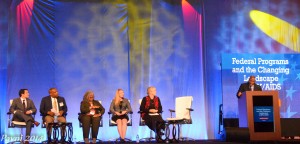USCA 2014: Federal HIV Programs in Spotlight
Topics

Federal HIV programs were in the spotlight at the 2014 U.S. Conference on AIDS as Mr. Douglas Brooks, Director of the White House Office of HIV/AIDS Policy, led a plenary session featuring representatives of a diverse array of HIV activities from across the federal government.
ONAP Priorities
Mr. Brooks opened the session with video greetings from Ms. Cecelia Munoz, Assistant to the President and Director of the Domestic Policy Council. Ms. Munoz thanked the conference participants for their work to achieve an AIDS-free generation, observing that she is proud to work for a President who is committed to working to address the HIV epidemic as well as the stigma that thwarts the progress possible, particularly among gay and bisexual men of color. She underscored that national HIV goals can only be accomplished by everyone working together, sharing information, and taking full advantage of all the opportunities made available through the Affordable Care Act.

Mr. Brooks highlighted his office’s priorities, all focused on achieving the goals of the National HIV/AIDS Strategy (NHAS), which include, among others, pursuing implementation of the President’s HIV Care Continuum Initiative introducing some of these federal employees.
Mr. Brooks then invited a panel of representatives from several federal HIV programs to share highlights of current or new activities. Here are some highlights from their conversation:
HRSA
HRSA’s HIV/AIDS Bureau has focused effort this year on ensuring that Ryan White clients gain access to health coverage via insurance available in the Marketplace or via Medicaid, observed Dr. Laura Cheever, HRSA’s Associate Administrator for the HIV/AIDS Bureau. She also noted that, among other things, HRSA is developing resources to support health insurance literacy to help individuals take full advantage of their new coverage.
HUD
The U.S. Department of Housing and Urban Development (HUD) re-submitted a legislative proposal to Congress to update the formula used for disseminating funds under the Housing Opportunities for People with AIDS (HOPWA)Exit Disclaimer program, reported Ms. Amy Palilonis of HUD’s Office of HIV/AIDS Housing. As called for in the NHAS, the proposed new formula will allow HOPWA funds to be distributed more effectively to communities where there is greatest need. The current formula is based on cumulative AIDS cases and, as a result, she noted, more than one half of the individuals counted in the dataset used to allocate those resources have died. HUD’s proposal to Congress to would base the HOPWA formula on living HIV cases and also factor in a community’s housing cost and poverty data from the community. Ms. Palilonis also shared that as part of HUD’s response to the President’s HIV Care Continuum Initiative, HUD’s Fair Housing Office is collaborating with the U.S. Department of Justice to develop materials to inform people how to report instances of HIV-related housing discrimination.
NIH
As the largest funder of HIV research in the world, a great variety of important research activity is currently being supported by the National Institutes of Health (NIH), observed Dr. Gina Brown, Coordinator of Microbicides and Women and Girls HIV Research at NIH’s Office of AIDS Research. While the majority of NIH funds are invested in research, she also observed that NIH has important initiatives that support information dissemination through channels such as AIDSinfo as well as investments in training the next generation of researchers, including a new program to be announced later in the conference to focus on HIV in Latino communities.
CDC
CDC has continued to utilize a High Impact Prevention approach, shared Dr. Eugene McCray, Director of CDC’s Division of HIV/AIDS Prevention, focusing its efforts on cost-effective, scaleable approaches that will have greatest impact of the epidemic, and using HIV surveillance data to inform programs. Dr. McCray also highlighted several important HIV awareness, prevention, and treatment campaigns that are part of CDC’s Act Against AIDS initiative, including recently launched campaigns focused on the Latino community as well as people living with HIV. Dr. McCray also highlighted a current funding opportunity announcement to support community-based organizations to implement High Impact Prevention among the populations most affected by HIV. This initiative will invest $200 million over 5 years. He referenced a number of upcoming technical assistance opportunities for interested applicants.
Department of Labor
Mr. Dylan Orr, Chief of Staff at the Office of Disability Employment Programs at the U.S. Department of Labor, announced the launch of a new online curriculum, Getting to Work, for HIV services and housing providers. Developed in collaboration with HUD, the curriculum features best practices, research, recommendations, and resources for service providers to assist PLWHA with entering or returning to work.
These and other federal programs were also represented and discussed during many sessions at the conference as well as in the exhibit hall.